The World Trade Center was designed by Minoru Yamasaki working under the New York firm Emery Ross and Sons, construction began in 1966 and was completed in 1977.
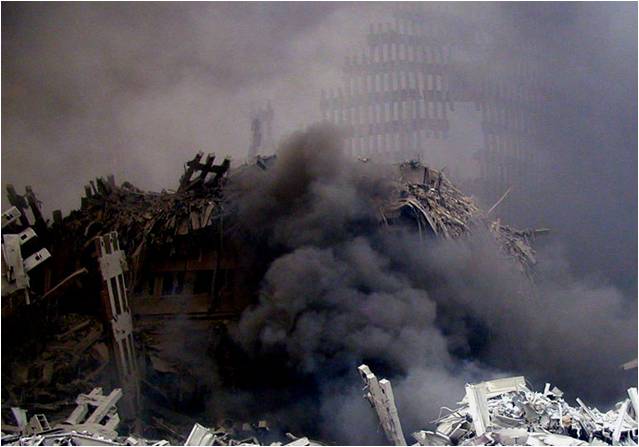
“….The World Trade Center is a living symbol of man’s dedication to world peace … beyond the compelling need to make this a monument to world peace, the World Trade Center should, because of its importance, become a representation of man’s belief in humanity, his need for individual dignity, his beliefs in the cooperation of men, and through cooperation, his ability to find greatness…” – Minoru Yamasaki
On Tuesday, September 11, 2001, at 8:45am New York local time, One World Trade Center, the north tower, was hit by a hijacked 767 commercial jet airplane, loaded with fuel for a trans-continental flight. Two World Trade Center, the south tower, was hit by a similar hijacked jet 18 minutes later at 9:03am.
The south tower, WTC 2, which had been hit second, was the first to suffer a complete structural collapse at 10:05am, 62 minutes after being hit itself, 80 minutes after the first impact. The north tower, WTC 1, then also collapsed at 10:29am, 104 minutes after being hit. WTC 7, a substantial 47 story office building in its own right, built in 1987, was damaged by the collapsing towers, caught fire, and later in the afternoon also totally collapsed.
In the summer of 2002, following the release of the six preliminary design concepts, LMDC initiated a worldwide search for design and planning professionals to propose a visionary land use plan for the World Trade Center area.
Memorial Plaza
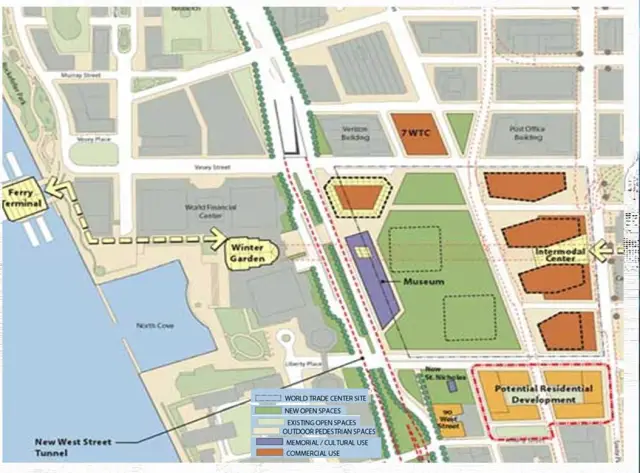
- 8-acre plaza with a memorial/cultural building on the western edge.
- 18.1 total acres of new public space, including parks, streets, sidewalks, and grand promenade.
- 100 feet of West Street reclaimed at grade for open space and museum facility.
- 5 towers (1 at 79 stories, 2 at 67 stories, and 2 at 62 stories).
- 1,500 foot high skyline element
*
Memorial Square
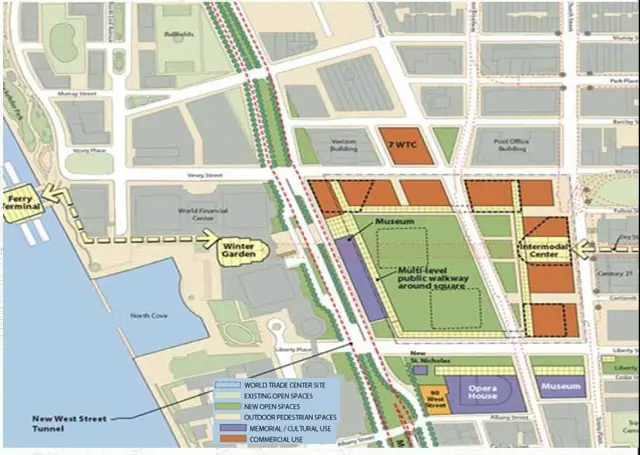
- 10-acre square, with a memorial/cultural building on the western edge
- Public arcades and rooftops overlooking square
- 24.1 total acres of public space, including parks, streets, sidewalks, public arcades, and grand promenade
- 4 towers (1 at 80 stories, 2 at 70 stories, 1 at 56 stories)
- 1,500 foot high skyline element
Memorial Triangle
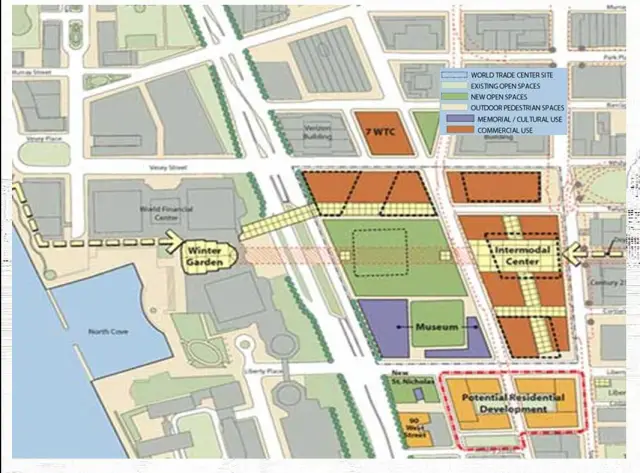
- 10-acre square, with a memorial/cultural building on the western edge
- Public arcades and rooftops overlooking square
- 24.1 total acres of public space, including parks, streets, sidewalks, public arcades, and grand promenade
- 4 towers (1 at 80 stories, 2 at 70 stories, 1 at 56 stories)
- 1500 foot high skyline element
Votives in Suspension
In their absence, the World Trade Center Towers have attained a greater degree of symbolic significance, their meaning instantaneously transformed on September 11, 2001. As monumental buildings, they were symbols of American capitalism, as voids, they now represent a concept of loss unparalleled in both scale and complexity. Our proposal for the WTC memorial aims to transform the towers’ footprints into dual sanctuary spaces that resonate profoundly with a sense of both individual and collective.
The memorial sanctuaries will be set into the earth and semi-enclosed from the outside. Only narrow gaps that outline each footprint will allow sunlight to penetrate into these sacred areas. Austere and minimal, the exteriors will give no indication of their interior space. From street level, the sanctuaries’ monolithic expanses will invite contemplation and suggest absence.
Once on the memorial grounds, the sanctuaries will only be made visible to visitors by long parapet walls that surround the footprints of the original towers. Most of this area will be kept as green park space providing a versatile venue for memorial ceremonies. Visitors will also be visually drawn to the exposed slurry walls on the western edge of the site as well as the Liberty Wall located on the southern side. The Liberty Wall will be engraved with monumental text that provides a didactic historical timeline of the World Trade Center site.
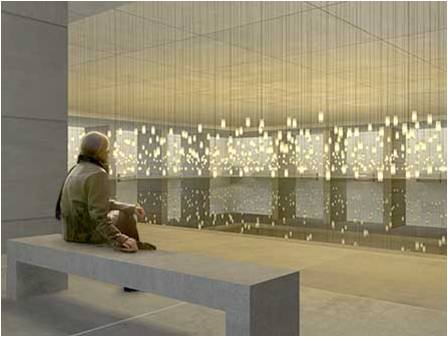
Votives in memorial sanctuary representing each victim
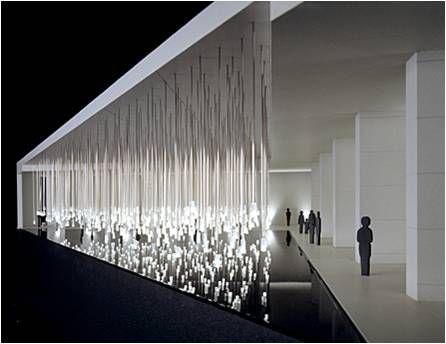
Model, section of memorial sanctuary
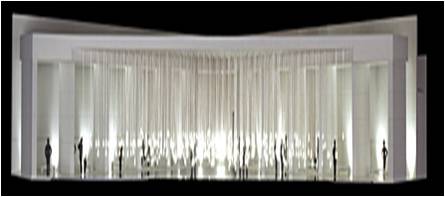
Model, section of memorial sanctuary 2
Visitors will descend down a stairway or lift system into each sanctuary, emerging into a darkened, serene environment. Here they will witness an expansive field of votive lights suspended in mid-air creating a sublimely beautiful downpour of loss. The votives, each representing a victim of the terrorist attacks, hang down on cables from the sanctuary ceiling just above a reflecting pool. The cables will function as capillaries that channel liquid fuel into the votives to sustain the symbolic flames.
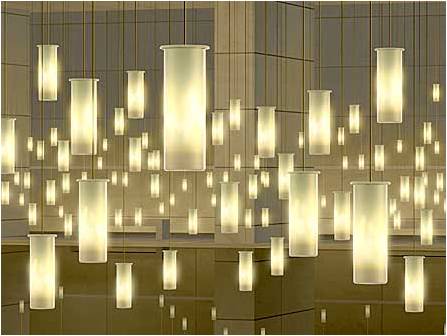
Details, votives in memorial sanctuary representing each victim
The age of each victim is used to determine the height of the suspended votives creating an irregular field of light that both breaks apart into fragments and coalesces as an entirety. This reinforces the memorial mission to convey both the overall magnitude of loss and pay tribute to individual lives. As a part of the memorial’s creation, victims’ families and friends will be invited to light the votives that represent their lost loved ones. Each flame, therefore, will be created by an individual act of remembrance.
Lower Waters
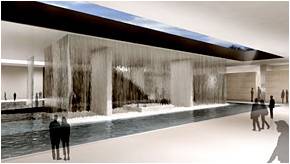
Water and light symbolize life, rejuvenation and rebirth. By using water and light as key elements of the design and by bringing people directly to the site of the attacks, we hope that visitors will remember not only the loss of life but also the sanctity of life that we live each day. These elements point to the passing of time, and speak to us of emotion and transcendence. The site is designed to provide a place in this city and within each of us where we may find peace in experiencing the challenging, often painful cycle of death, grief, rebirth and life.
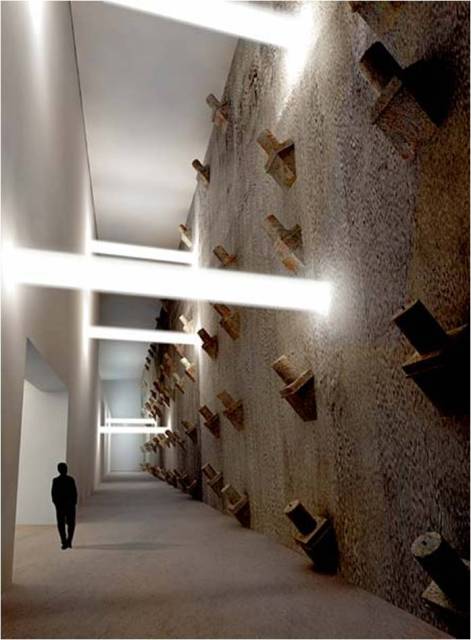
View of slurry wall at bedrock
Our physical movement throughout the site, the inclined park and the various levels of memorial and museum, represents our emotional movement through the experiences of memory, grief, discovery, hope, and rebirth. We descend to the memorial spaces, the literal and figurative centers, and to the Museum of September 11. Our contact with the names of the victims, their final resting place, the original slurry wall, and bedrock level of the World Trade Center causes us to contemplate the profound loss suffered on September 11 and to be grateful for the many that were saved. As we ascend, we come back to the city and ourselves transformed by the emotional and historic magnitude of that day.
Inversion of Light
As a human being and a witness to the great tragedies of September 11, 2001, and the 1993 terrorist bombings, I seek a way to remember and honor the thousands of innocent lives that were lost and the courage of the heroes. I seek to address this project as a challenge to inspire the human mind and to reaffirm respect for life, to strengthen our resolve to preserve freedom, and to bring about an end to hatred, ignorance, and intolerance.
To enter the underground area of the memorial, one descends a ramp leading to where the victims are represented as light, water, and air. Within the north tower’s footprint, representative floor plan, based on those of the ninety-fourth and ninety-fifth floors, is illuminated from below; the light is blocked in the central area of the plan. On the north wall of the memorial, where the first plane hit, an extended curtain of clear glass will be etched with the names of the lost individuals. The victim’s names will be sorted in two main categories, designated by 2001 and 1993.
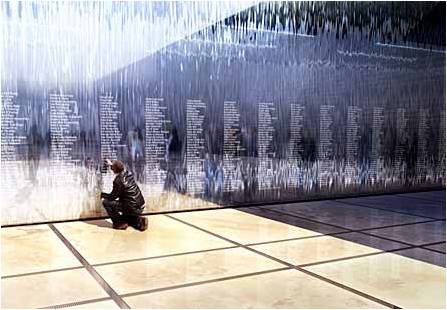
Glass wall of names
Behind the glass and along its length and height, water will trickle continuously, representing the eternal movement of life through time. The black-granite east and west walls will be etched with the memorial mission statement and the heroes’ insignias; the east wall with the history of events.
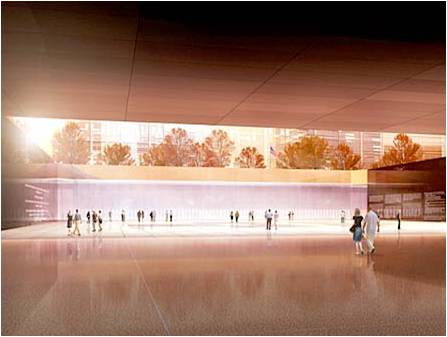
North tower footprint area, seen from below
In footprint of the south tower, a reflection pond will serve as a tribute to the spirits of the victims; at night, it will be illuminated from beneath by a circle of lights projecting into the sky. In winter, the heat of the lights will vaporize the water and create the image of flames on its surface.
The centrally located unidentified-remains area is enclosed in two semicircular glass walls, unified above by a circular skylight that emerges in the curvilinear park. From this central column ripples out a horizontal configuration that incorporates all elements of the memorial and its surroundings-all columns, the main ramp, all lighting, the museums, the footprints and elements within, and the geography of the surrounding urban grid, extending to the Statue of Liberty and, perhaps, beyond. From this column a blue laser light shines into the universe, connecting the geometry and geography of the earth with the geometry and eternity of the universe.
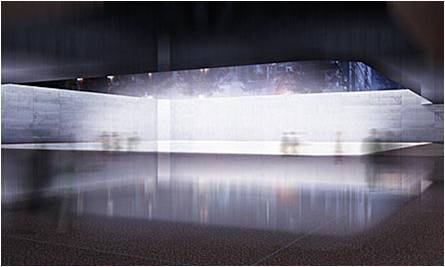
Reflection pool at South tower footprint, night
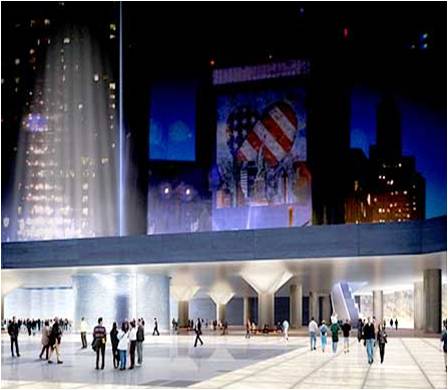
View from Northwest corner
The proposed memorial, conceptually called Inversion of Light, is a living memorial. Dedicated to world peace, it will ensure that future generations never forget this great tragedy. We, as human beings, hope that we can serve this memory well and lead ourselves toward peacefulness, tranquility, and purity of contemplation. We, as part of the greater universe, hope to transcend the suffering of any single generation and come to an understanding of the authenticity of eternity and the vindication of truth.
Garden of Lights
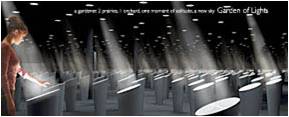
There was a last hour, a last minute, a last second that 2,982 stars went dark. The instant there was this last light there was a first light, 2,982 stars were born. A new constellation expands across the entire site; a new garden expands across the entire site. Time and space slow as the lights from the constellation pass through the garden, through the earth, and create the new constellation below. Above there is the garden, below there is a new sky and 2,982 stars.
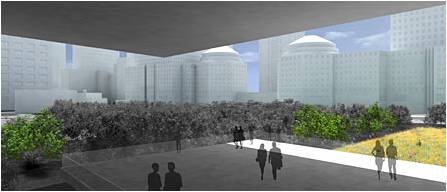
Garden from September 11 Place
The garden of lights links the sky above to the new sky below. A glass wall surrounds this garden of lights. When it opens everyday from 8:46am to 10:29am it is a breath, a new rhythm for the city. The seed of the garden is the courage of the past. A gardener is invited from a different part of the world each year to nurture this seed. The footprints teem with life, a prairie. Between the footprints the gardener raises an orchard. Each season we walk a new path through the prairie and new seeds grow on the old path. In September the orchard gives fruit, the gift of life nourished by light.
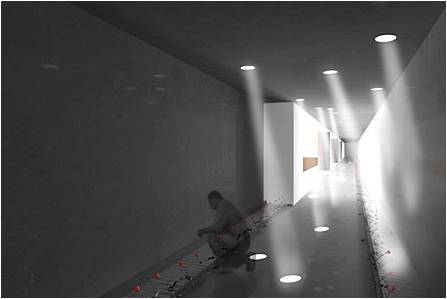
Passage of light
In the garden of lights we can look down the path of each light. We see the name inscribed in stone and the light from the shining star. A cloud passes over the city; it is a shadow on the garden, a sparkle in the stars below, a glimmer on the altar, a flicker in the soul.
Passages of Light: Memorial Cloud
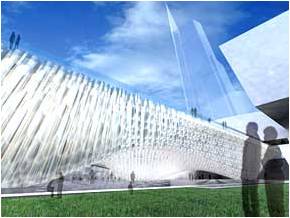
Daytime view of Memorial Cloud
Through “Passages of Light : The Memorial Cloud,” we wish to create upon a site scarred by a terrifying loss, sorrow, and grief, a work of shared and individual mourning, as well as a gesture affirming our hopes, common dreams, and ability to rebuild.
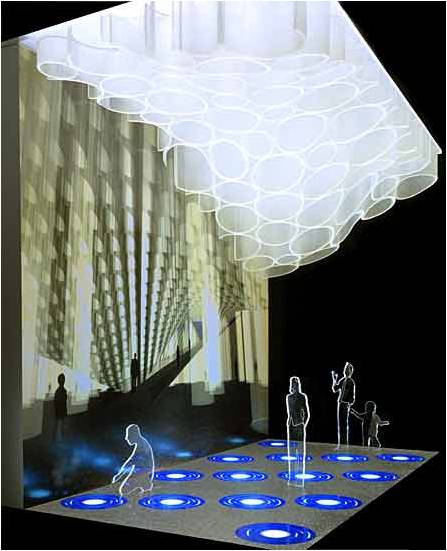
Circles of Light with victims’ names
Together, the names form a design that we term the “Pompeii Scheme,” because it represents individuals equally in the course of their lives, cut short by the attacks. A name appears near those of the people with whom he or she died. For example, the approximately 1400 individuals who perished in Tower One define the largest field of lights. This field is continuous with the group of approximately 600 who died in the second tower. The design’s appearance reflects the cloud’s topology of cupolas. A “Line of Rescuers” runs through both groups, where Firefighters, Police, and ordained and medical people can be represented
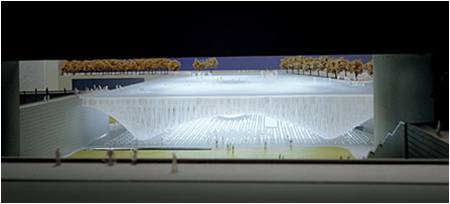
Model, sectional view
Our design is guided by our respect for the sacred ground. Accordingly, we limit the cloud to touching the ground for support on only five points; we judiciously open the earth beneath the World Trade Center Tower footprints only to provide visitors access to the symbolic “bedrock” level, creating thereby a processional passage of light and subterranean darkness. The procession that carries visitors beside the repository for the “unidentified remains” connects both footprints with the channel along the exposed slurry wall.
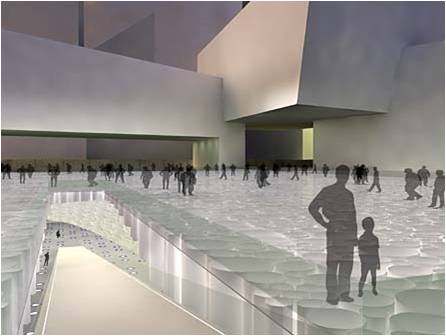
Through the Memorial Cloud we hope to elicit two more responses, one highly physical, the other imaginative, both of awe. One recovers a sensation associated with the World Trade Center Towers when we recall standing in their presence: the urge to look skywards, a vertical gesture associated with hope. With the second gesture we seek to give expression to a relation between those we mourn and those who live on affected by the tragedy and repercussions of the attacks.
Suspending Memory
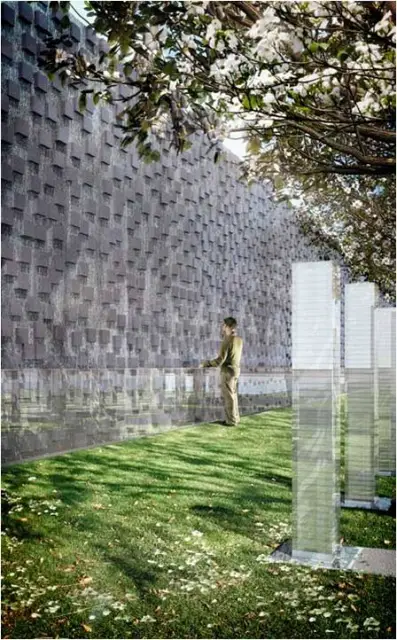
North garden with stones representing each victim
Upon entering the North garden, visitors are greeted with a natural stone wall inlaid with 2982 randomly protruding polished squares. This wall spans the length of the island, shielding it from its frenetic surroundings. Water trickles from an opening at the base of each square into a pristine reflecting pool. The Pool of Tears enfolds the entire memorial site forever preserving Ground Zero as hallowed ground. The expanse of this pool is a metaphor of the collective tears shed by millions around the world.
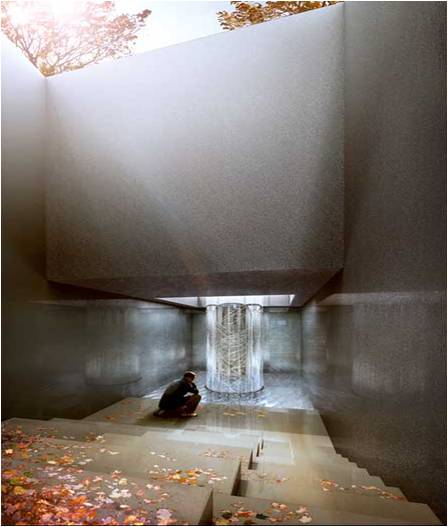
Space for reflection in North memorial garden island
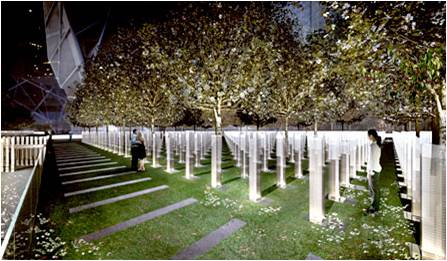
Nighttime view of memorial garden
The memorials become the embodiment of each victim representing them as a summation of time; a collection of moments recorded in each life. Together they form a place of hope and tranquil beauty suspended in a sea of calming motion.
Reflecting Absence
This design proposes a space that resonates with the feelings of loss and absence that were generated by the death and destruction at the World Trade Center. A pair of reflective pools marks the location of the towers’ footprints. The surface of these pools is broken by large voids. These voids can be read as containers of loss, being close-by yet inaccessible.
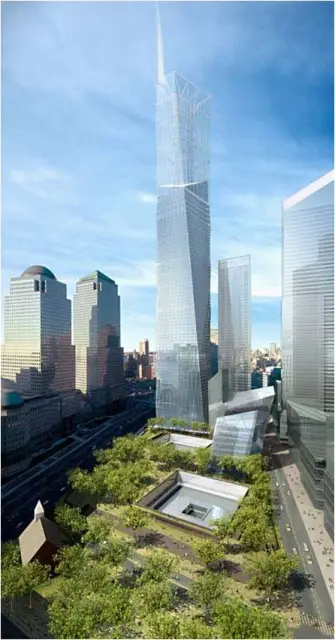
Aerial view from Southeast
The pools are submerged thirty feet below street level in the middle of a large open plaza. They too are large voids, open and visible reminders of the absence. The pools are fed by a constant stream of water, cascading down the walls which enclose them.
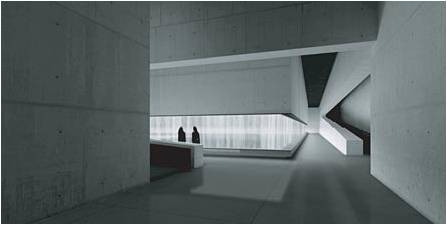
Entrance under reflective pool
Bordering each pool is a pair of sloped buildings. These buildings create a sense of enclosure, capturing the exposed outer corners of the memorial site and defining a path of circulation around each pool. They also guide visitors to the site into the memorial itself.
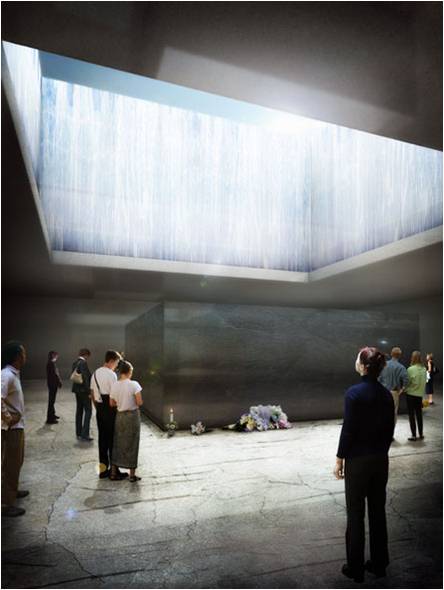
Unidentified remains at bedrock – North Tower footprint
The end of a visit to the memorial is marked by an ascent back to street level. Visitors are again ensconced by darkness, but now the long and narrow passageway leads up towards daylight. As they emerge from the ramped enclosure, they find themselves back in the open plaza.
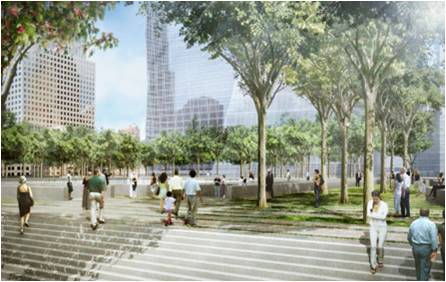
View of Plaza level
The western edge of the plaza is bounded by a cultural building that shelters the site from the highway. The remaining three sides are open and link the plaza to adjacent streets and neighborhoods. Tall pines punctuate the plaza’s surface, softening its character and creating shaded areas within this large outdoor room. Designed to be a mediating space, the plaza belongs both to the city and to the memorial. It encourages uses that are both contemplative and everyday. It is a living part of the city

very nice informative
very nice informative article…